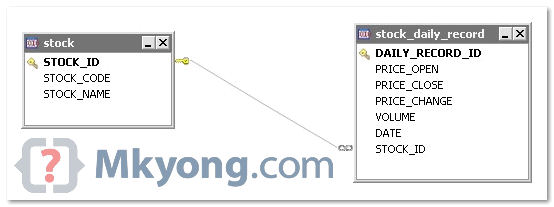Always put inverse=”true” in your collection variable ?
There are many Hibernate articles try to explain the “inverse” with many Hibernate “official” jargon, which is very hard to understand (at least to me). In few articles, they even suggested that just forget about what is “inverse”, and always put inverse=”true” in the collection variable.
There are many Hibernate articles try to explain the “inverse” with many Hibernate “official” jargon, which is very hard to understand (at least to me). In few articles, they even suggested that just forget about what is “inverse”, and always put inverse=”true” in the collection variable.
This statement is always true – “put inverse=true in collection variable”, but do not blindfold on it, try to understand the reason behind is essential to optimal your Hibernate performance.
What is “inverse” ?
This is the most confusing keyword in Hibernate, at least i took quite a long time to understand it. The “inverse” keyword is always declare in one-to-many and many-to-many relationship (many-to-one doesn’t has inverse keyword), it means which side is responsible to take care of the relationship.
“inverse”, should change to “relationship owner”?
In Hibernate, only the “relationship owner” should maintain the relationship, and the “inverse” keyword is created to defines which side is the owner to maintain the relationship. However the “inverse” keyword itself is not verbose enough, I would suggest change the keyword to “relationship_owner“.
In short, inverse=”true” means this is the relationship owner, and inverse=”false” (default) means it’s not.
1. One to many Relationship
This is a one-to-many relationship table design, a STOCK table has many occurrences in STOCK_DAILY_RECORD table.

2. Hibernate Implementation
See the Hibernate implementation in XML mapping files.
File : Stock.java
Java
public class Stock implements java.io.Serializable {
...
private Set<StockDailyRecord> stockDailyRecords =
new HashSet<StockDailyRecord>(0);
...
File : StockDailyRecord.java
Java
public class StockDailyRecord implements java.io.Serializable {
...
private Stock stock;
...
File : Stock.hbm.xml
Markup
<hibernate-mapping>
<class name="com.mkyong.common.Stock" table="stock" ...>
...
<set name="stockDailyRecords" table="stock_daily_record" fetch="select">
<key>
<column name="STOCK_ID" not-null="true" />
</key>
<one-to-many class="com.mkyong.common.StockDailyRecord" />
</set>
...
File : StockDailyRecord.hbm.xml
Markup
<hibernate-mapping>
<class name="com.mkyong.common.StockDailyRecord" table="stock_daily_record" ...>
...
<many-to-one name="stock" class="com.mkyong.common.Stock">
<column name="STOCK_ID" not-null="true" />
</many-to-one>
...
3. inverse = true / false
Inverse keyword is applied in one to many relationship. Here’s the question, if save or update operation perform in “Stock” object, should it update the “stockDailyRecords” relationship?
File : Stock.hbm.xml
Markup
<class name="com.mkyong.common.Stock" table="stock" ...>
...
<set name="stockDailyRecords" table="stock_daily_record" inverse="{true/false}" fetch="select">
<key>
<column name="STOCK_ID" not-null="true" />
</key>
<one-to-many class="com.mkyong.common.StockDailyRecord" />
</set>
...
1. inverse=”true”
If inverse=”true” in the set variable, it means “stock_daily_record” is the relationship owner, so Stock will NOT UPDATE the relationship.
Markup
<class name="com.mkyong.common.Stock" table="stock" ...>
...
<set name="stockDailyRecords" table="stock_daily_record" inverse="true" >
2. inverse=”false”
If inverse=”false” (default) in the set variable, it means “stock” is the relationship owner, and Stock will UPDATE the relationship.
Markup
<class name="com.mkyong.common.Stock" table="stock" ...>
...
<set name="stockDailyRecords" table="stock_daily_record" inverse="false" >
See more examples below :
4. inverse=”false” Example
If keyword “inverse” is not define, the inverse = “false” will be used, which is
Markup
<!--Stock.hbm.xml-->
<class name="com.mkyong.common.Stock" table="stock" ...>
...
<set name="stockDailyRecords" table="stock_daily_record" inverse="false">
It means “stock” is the relationship owner, and it will maintains the relationship.
Insert example …
When a “Stock” object is saved, Hibernate will generated three SQL statements, two inserts and one update.
Java
session.beginTransaction();
Stock stock = new Stock();
stock.setStockCode("7052");
stock.setStockName("PADINI");
StockDailyRecord stockDailyRecords = new StockDailyRecord();
stockDailyRecords.setPriceOpen(new Float("1.2"));
stockDailyRecords.setPriceClose(new Float("1.1"));
stockDailyRecords.setPriceChange(new Float("10.0"));
stockDailyRecords.setVolume(3000000L);
stockDailyRecords.setDate(new Date());
stockDailyRecords.setStock(stock);
stock.getStockDailyRecords().add(stockDailyRecords);
session.save(stock);
session.save(stockDailyRecords);
session.getTransaction().commit();
Output…
SQL
Hibernate:
insert
into
mkyongdb.stock
(STOCK_CODE, STOCK_NAME)
values
(?, ?)
Hibernate:
insert
into
mkyongdb.stock_daily_record
(STOCK_ID, PRICE_OPEN, PRICE_CLOSE, PRICE_CHANGE, VOLUME, DATE)
values
(?, ?, ?, ?, ?, ?)
Hibernate:
update
mkyongdb.stock_daily_record
set
STOCK_ID=?
where
RECORD_ID=?
Stock will update the “stock_daily_record.STOCK_ID” through Set variable (stockDailyRecords), because Stock is the relationship owner.
Note
The third statement is really NOT necessary.
The third statement is really NOT necessary.
Update example …
When a “Stock” object is updated, Hibernate will generated two SQL statements, one inserts and one update.
Java
session.beginTransaction();
Stock stock = (Stock)session.get(Stock.class, 57);
StockDailyRecord stockDailyRecords = new StockDailyRecord();
stockDailyRecords.setPriceOpen(new Float("1.2"));
stockDailyRecords.setPriceClose(new Float("1.1"));
stockDailyRecords.setPriceChange(new Float("10.0"));
stockDailyRecords.setVolume(3000000L);
stockDailyRecords.setDate(new Date());
stockDailyRecords.setStock(stock);
stock.getStockDailyRecords().add(stockDailyRecords);
session.save(stockDailyRecords);
session.update(stock);
session.getTransaction().commit();
Output…
SQL
Hibernate:
insert
into
mkyongdb.stock_daily_record
(STOCK_ID, PRICE_OPEN, PRICE_CLOSE, PRICE_CHANGE, VOLUME, DATE)
values
(?, ?, ?, ?, ?, ?)
Hibernate:
update
mkyongdb.stock_daily_record
set
STOCK_ID=?
where
RECORD_ID=?
Note
Again, the third statement is NOT necessary.
Again, the third statement is NOT necessary.
5. inverse=”true” Example
If keyword “inverse=true” is defined :
Markup
<!--Stock.hbm.xml-->
<class name="com.mkyong.common.Stock" table="stock" ...>
...
<set name="stockDailyRecords" table="stock_daily_record" inverse="true">
Now, it means “stockDailyRecords” is the relationship owner, and “stock” will not maintains the relationship.
Insert example …
When a “Stock” object is saved, Hibernate will generated two SQL insert statements.
Java
session.beginTransaction();
Stock stock = new Stock();
stock.setStockCode("7052");
stock.setStockName("PADINI");
StockDailyRecord stockDailyRecords = new StockDailyRecord();
stockDailyRecords.setPriceOpen(new Float("1.2"));
stockDailyRecords.setPriceClose(new Float("1.1"));
stockDailyRecords.setPriceChange(new Float("10.0"));
stockDailyRecords.setVolume(3000000L);
stockDailyRecords.setDate(new Date());
stockDailyRecords.setStock(stock);
stock.getStockDailyRecords().add(stockDailyRecords);
session.save(stock);
session.save(stockDailyRecords);
session.getTransaction().commit();
Output …
SQL
Hibernate:
insert
into
mkyongdb.stock
(STOCK_CODE, STOCK_NAME)
values
(?, ?)
Hibernate:
insert
into
mkyongdb.stock_daily_record
(STOCK_ID, PRICE_OPEN, PRICE_CLOSE, PRICE_CHANGE, VOLUME, DATE)
values
(?, ?, ?, ?, ?, ?)
Update example …
When a “Stock” object is updated, Hibernate will generated one SQL statement.
Java
session.beginTransaction();
Stock stock = (Stock)session.get(Stock.class, 57);
StockDailyRecord stockDailyRecords = new StockDailyRecord();
stockDailyRecords.setPriceOpen(new Float("1.2"));
stockDailyRecords.setPriceClose(new Float("1.1"));
stockDailyRecords.setPriceChange(new Float("10.0"));
stockDailyRecords.setVolume(3000000L);
stockDailyRecords.setDate(new Date());
stockDailyRecords.setStock(stock);
stock.getStockDailyRecords().add(stockDailyRecords);
session.save(stockDailyRecords);
session.update(stock);
session.getTransaction().commit();
Output…
SQL
Hibernate:
insert
into
mkyongdb.stock_daily_record
(STOCK_ID, PRICE_OPEN, PRICE_CLOSE, PRICE_CHANGE, VOLUME, DATE)
values
(?, ?, ?, ?, ?, ?)
inverse vs cascade
Many people like to compare between inverse and cascade, but both are totally different notions, see the differential here.
Many people like to compare between inverse and cascade, but both are totally different notions, see the differential here.
Conclusion
Understanding the “inverse” is essential to optimize your Hibernate code, it helps to avoid many unnecessary update statements, like “insert and update example for inverse=false” above. At last, try to remember the inverse=”true” mean this is the relationship owner to handle the relationship.
Reference
- http://simoes.org/docs/hibernate-2.1/155.html
- http://docs.jboss.org/hibernate/stable/core/reference/en/html/example-parentchild.html
- http://tadtech.blogspot.com/2007/02/hibernate-when-is-inversetrue-and-when.html
Fuente:
java programming examples
ResponderEliminarReverse, Fill, Copy, Min and Max